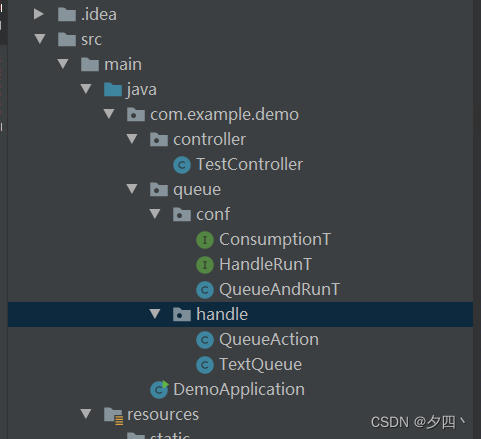Java 实现多线程Queue异步队列处理任务
开发任务中,对于一些业务类型可进行异步处理,不使用rpc,mq,@Async注解,一样异步处理操作
利用多线程,将多个数据推送到队列中,进行异步批量的处理

配置队列定义
public interface ConsumptionT<T> {
void start(String var1, HandleRunT<T> var2);
void stop();
void push(T var1) throws Exception;
}
public interface HandleRunT<T> {
void doRun(List<T> var1);
}
import java.util.Iterator;
import java.util.LinkedList;
import java.util.List;
import java.util.concurrent.LinkedBlockingQueue;
public class QueueAndRunT<T> implements ConsumptionT<T> {
final int SAVE_NUM = 30000;
LinkedBlockingQueue<T> queueList;
private String queueName;
private HandleRunT<T> runnable;
private Thread checkThread;
private List<Thread> threadList = new LinkedList();
private int runCount = 5;
private int runPop = 40;
private int runMaxCount = 20;
private boolean isRun = true;
private final int ONE_MIN = 600000;
private int waitTime = 300;
public QueueAndRunT() {
}
public void setWaitTime(int time) {
if (time > 0) {
this.waitTime = time;
}
}
public QueueAndRunT(int count, int pop, int maxCount) {
if (count > 0) {
this.runCount = count;
}
if (pop > 0) {
this.runPop = pop;
}
if (maxCount > 0) {
this.runMaxCount = maxCount;
}
}
public void start(String name, HandleRunT<T> c, int saveNum) {
this.queueList = new LinkedBlockingQueue(saveNum);
this.queueName = name;
this.runnable = c;
for (int i = 0; i < this.runCount; ++i) {
Thread thread = new Thread(new Runnable() {
@Override
public void run() {
while (QueueAndRunT.this.isRun) {
try {
QueueAndRunT.this.doRun();
} catch (Exception var2) {
System.err.println(QueueAndRunT.this.queueName + "运行错误:" + var2);
}
}
}
});
thread.start();
this.threadList.add(thread);
}
this.checkThread = new Thread(new Runnable() {
@Override
public void run() {
int wait = 0;
while (QueueAndRunT.this.isRun) {
try {
Thread.sleep((long) (600000 - wait));
wait = QueueAndRunT.this.checkRunSystem();
} catch (InterruptedException var3) {
}
}
}
});
this.checkThread.start();
}
private int checkRunSystem() {
long t1 = System.currentTimeMillis();
int size;
if (this.queueList != null) {
size = this.queueList.size();
int value = size + 1000;
if (value >= 30000 && this.runCount < this.runMaxCount) {
int capacity = this.runCount / 2;
if (capacity > 0) {
for (int i = 0; i < capacity; ++i) {
Thread thread = new Thread(new Runnable() {
public void run() {
while (QueueAndRunT.this.isRun) {
try {
QueueAndRunT.this.doRun();
} catch (Exception var2) {
}
}
}
});
thread.start();
this.threadList.add(thread);
}
this.runCount += capacity;
}
}
}
size = this.threadList.size();
System.err.println(this.queueName + "运行的线程数为:" + size);
return (int) (System.currentTimeMillis() - t1);
}
private void doRun() throws Exception {
List<T> readList = new LinkedList();
for (int i = 0; i < this.runPop; ++i) {
T poll = this.queueList.poll();
if (poll == null) {
break;
}
readList.add(poll);
}
if (!readList.isEmpty()) {
this.runnable.doRun(readList);
} else {
Thread.sleep((long)this.waitTime);
}
}
@Override
public void start(String name, HandleRunT<T> c) {
this.start(name, c, 30000);
}
@Override
public void stop() {
this.isRun = false;
if (this.threadList != null && !this.threadList.isEmpty()) {
Iterator var1 = this.threadList.iterator();
while (var1.hasNext()) {
Thread thread = (Thread) var1.next();
thread.interrupt();
}
}
}
@Override
public void push(T t) throws Exception {
if (t != null) {
this.queueList.put(t);
}
}
}
队列启动初始化
import lombok.RequiredArgsConstructor;
import lombok.extern.slf4j.Slf4j;
import org.springframework.boot.CommandLineRunner;
import org.springframework.core.annotation.Order;
import org.springframework.stereotype.Component;
import javax.annotation.PreDestroy;
@Order(Integer.MIN_VALUE)
@Slf4j
@Component
@RequiredArgsConstructor
public class QueueAction implements CommandLineRunner {
private final TextQueue textQueue;
@Override
public void run(String... args) throws Exception {
textQueue.start();
log.info("队列初始化成功");
}
@PreDestroy
public void destroy() {
textQueue.stop();
}
}
实际应用队列
import com.example.demo.queue.conf.HandleRunT;
import com.example.demo.queue.conf.QueueAndRunT;
import lombok.RequiredArgsConstructor;
import lombok.extern.slf4j.Slf4j;
import org.springframework.stereotype.Component;
import java.util.List;
@Slf4j
@Component
@RequiredArgsConstructor
public class TextQueue {
private QueueAndRunT<String> queueAndRunT;
private String name = "textQueue";
public void start() {
queueAndRunT = new QueueAndRunT(5, 5000, 10);
queueAndRunT.start(name, new HandleRunT<String>() {
@Override
public void doRun(List<String> list) {
try {
System.out.println(list.size());
for (String cardImportDTO : list) {
System.out.println(cardImportDTO);
}
} catch (Exception e) {
log.info("处理失败:{}", e.getMessage());
}
}
});
}
public void stop() {
if (queueAndRunT != null) {
queueAndRunT.stop();
}
}
public void push(String simInfo) {
try {
queueAndRunT.push(simInfo);
} catch (Exception e) {
log.warn("push错误:" + e.getLocalizedMessage());
}
}
}
@Slf4j
@RestController
@RequiredArgsConstructor
@RequestMapping(value = "/test", produces = MediaType.APPLICATION_JSON_VALUE)
public class TestController {
private final TextQueue textQueue;
@GetMapping("/test")
public void getById(@RequestParam("str") String str) {
for (int i = 0; i < 5000; i++) {
textQueue.push(str + i);
}
}
}






















 778
778











 被折叠的 条评论
为什么被折叠?
被折叠的 条评论
为什么被折叠?








